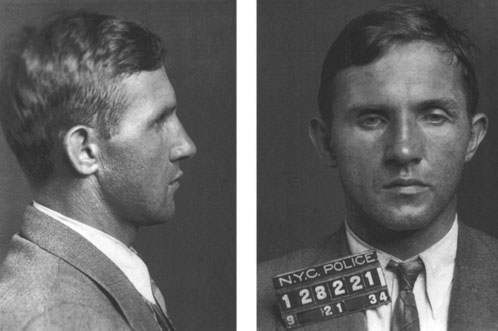
With the help of a friend, Fritz Petzold, Hauptmann burglarized three
homes. In a more daring daylight robbery, the two accosted two women
at gunpoint and stole their food coupons – the women were pushing baby
carriages down a city street. In short order, Hauptmann was tried
and convicted. Although he was sentenced to five years and one week
in prison, he was paroled after four years. Soon after being released,
he was arrested again and charged with stealing some strips of leather
belting. While awaiting trial, Hauptmann escaped from prison.
He left his neatly folded prison clothes on the front stairs with a note
which read: “Best wishes to the police.” Hauptmann subsequently made two failed attempts to come to the United
States. Both times, he was returned to Germany. On his third
attempt, in November of 1923, he successfully entered the United States
using a disguise and a stolen landing card. The following spring,
he met Anna Schoeffler – a German immigrant who lived in Queens.
In October of 1925, they were married.
Life in the United States was good to the Hauptmanns. Anna worked
in a bakery and Hauptmann was a carpenter. They lived in a comfortable
home in the Bronx.
In September of 1935, a $10 gold certificate from the Lindbergh ransom
money with a license plate number written on it was discovered at a local
bank. The license plate belonged to Bruno Richard Hauptmann.
Soon thereafter Hauptmann was arrested and charged with the Lindbergh kidnapping.
During a search of Hauptmann’s house and garage, nearly $15,000 of the
Lindbergh ransom money and a plank containing the address and phone number
of Dr. John Condon was found.
The state’s case against Hauptmann was compelling. Hauptmann was
positively identified by Dr. John Condon as the man with whom Dr. Condon
had met and delivered the ransom money. Prosecution experts testified
that the ladder used in the kidnapping had been made from wood found in
Hauptmann’s attic and that Hauptmann’s handwriting matched that found on
the ransom notes. Eyewitnesses testified that it was Hauptmann who
had spent some of the Lindbergh gold certificates and that he had been
seen in the area of the Hopewell estate on the day of the kidnapping.
Based on this evidence, Hauptmann was convicted and sentenced to death.
Repinted from:
http://www.law.umkc.edu
 Born
in 1899 in Germany, Bruno Richard Hauptmann had served as a teenaged machine
gunner in the German infantry on the western front. He lost two brothers
in the war. In post-war Germany, unemployment was rife; food was
scarce. With only eight years of general education and two years
of trade school – where he learned carpentry and machinery – Hauptmann
was unable to secure gainful employment. In March of 1919, he turned
to crime.
Born
in 1899 in Germany, Bruno Richard Hauptmann had served as a teenaged machine
gunner in the German infantry on the western front. He lost two brothers
in the war. In post-war Germany, unemployment was rife; food was
scarce. With only eight years of general education and two years
of trade school – where he learned carpentry and machinery – Hauptmann
was unable to secure gainful employment. In March of 1919, he turned
to crime.

 Throughout the proceedings, Hauptmann maintained his innocence, claiming
that the money found in his garage had belonged to a deceased friend, Isidore
Fisch. He further maintained that he had not turned the gold certificates
in because he was an illegal alien and he feared being deported.
Hauptman was executed on April 3, 1936.
Throughout the proceedings, Hauptmann maintained his innocence, claiming
that the money found in his garage had belonged to a deceased friend, Isidore
Fisch. He further maintained that he had not turned the gold certificates
in because he was an illegal alien and he feared being deported.
Hauptman was executed on April 3, 1936.
Privacy Policy | Terms and Conditions | This site is not affiliated with the Lindbergh family,
Lindbergh Foundation, or any other organization or group.
This site owned and operated by the Spirit of St. Louis 2 Project.
Email: webmaster@charleslindbergh.com
® Copyright 2014 CharlesLindbergh.com®, All rights reserved.
Help support this site, order your www.Amazon.com materials through this link.
